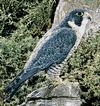- peregrine falcon
-
a globally distributed falcon, Falco peregrinus, much used in falconry because of its swift flight: several subspecies are endangered. See illus. under falcon.[1350-1400; ME]
* * *
or duck hawkFalcon species (Falco peregrinus) found worldwide but rare today because of bioaccumulation of pesticides.Peregrines are 13–19 in. (33–48 cm) long and gray above, with black-barred whitish underparts. They fly high and dive at tremendous speed (up to 175 mph, or 280 kphthe greatest speeds attained by any bird), striking with clenched talons and killing by impact. They usually nest in a scrape on a high cliff ledge near water, where bird prey is plentiful. Breeding programs have reintroduced the species into the wild and introduced it into urban areas, where it finds a clifflike habitat among skyscrapers and preys chiefly on the rock dove (see pigeon). Despite the programs' success, the species remains vulnerable. Peregrine falcon (Falco peregrinus)Kenneth W. FinkRoot Resources
Peregrine falcon (Falco peregrinus)Kenneth W. FinkRoot Resources* * *
▪ birdthe most widely distributed bird of prey species, with breeding populations on every continent and many oceanic islands. Sixteen subspecies are recognized.Coloration is a bluish gray above, with black bars on the white-to-yellowish-white underparts. Peregrines range from about 33 to 48 cm (13 to 19 inches) long. Strong and fast, they hunt by flying high and then diving at their prey. Attaining tremendous speeds (up to 320 km [200 miles] per hour), they strike with clenched talons and kill by impact. The prey includes ducks and shorebirds. Peregrines inhabit rocky open country near water where birds are plentiful. The usual nest is a mere scrape on a ledge high on a cliff, but a few populations use city skyscrapers or tree nests built by other bird species. The clutch is three or four reddish brown eggs, and incubation lasts about a month. The young fledge in five to six weeks.Captive peregrine falcons have long been used in the sport of falconry. After World War II, the peregrine falcon suffered a precipitous population decline throughout most of its global range. In most regions, including North America, the chief cause of the decline was traced to the pesticide DDT, which the birds had obtained from their avian prey. The chemical had become concentrated in the peregrine's tissues and interfered with the deposition of calcium in the eggshells, causing them to be abnormally thin and prone to breakage. In the British Isles, direct mortality from another pesticide, dieldrin, was the most important cause of the decline. Following the banning or great reduction in the use of most organochlorine pesticides, populations have rebounded in virtually every part of the world and now exceed historical levels in many regions.The American peregrine falcon (F. peregrinus anatum), which once bred from Hudson Bay to the southern United States, was formerly an endangered species. It had completely vanished from the eastern United States and eastern boreal (boreal forest) Canada by the late 1960s. After Canada had banned DDT use by 1969 and the United States by 1972, vigorous captive breeding and reintroduction programs were initiated in both countries. Over the next 30 years, more than 6,000 captive progeny were released to the wild. North American populations recovered completely, and since 1999 the peregrine has not been listed as endangered.Lloyd Kiff* * *
Universalium. 2010.
